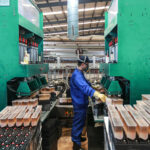
CATL is on its way to revolutionize battery swapping in China.Source: EVOGO
CATL is on its way to revolutionize battery swapping in China
- CATL says “chocolate battery” can be used in 80% of EV models currently available on the global market and all EVs to be released in the next three years.
- Chairman Robin Zeng is confident that Evogo-compatible vehicles will increase.
For a common electric vehicle (EV) to be fully charged, it can take more than an hour. In contrast, swapping in a new battery only takes minutes — five at most. Yet, battery-swapping has never become a mainstream charging method, despite the fact that EV adoption has grown significantly over the past decade. But that has not been the case for China — where batteries turned mainstream before the world caught on to its trend, so much so it can be dubbed as a ‘battery-as-a-service’ model.
BaaS, as the model is known, will allow drivers to rent and swap out batteries under a subscription pricing model. A depleted battery can be swapped for a fresh one in as little as a minute, according to Contemporary Amperex Technology (CATL), China’s leading manufacturer of automobile batteries. The company, also the world’s largest manufacturer of EV batteries, had launched its EVOGO battery swap service in China earlier this year, starting with four stations on Xiamen Island.
CATL’s plan is to expand to ten Chinese cities, with an aim for ‘battery-as-a-service’ hegemony in the country, according to Nikkei’s report this week. It started in January this year, when the company announced a decision to offer a system for swapping modular batteries under the brand of Evogo through its wholly owned subsidiary Contemporary Amperex Energy Service Technology. Then in June, the company started building a battery swapping station in Hefei, in the central Chinese province of Anhui.
It plans to set up 30 and 20 stations in Amoy and Hefei, respectively, by the end of this year. CATL had in fact begun the swap service for local taxi companies in Amoy since April at a battery swapping station it built. “Vehicles are mechanically lifted so their batteries can be replaced from below. Drivers do not even need to get out during the automated process,” Nikkei’s report stated.
How does CATL battery swapping work in China?
According to CATL, a standard station takes up around 40 square meters of land and keeps 48 “chocolate” replacement lithium-ion battery packs, shaped like chocolate bars, each offering a driving range of around 200 kilometers. Users of CATL’s battery service are allowed to swap up to three packs per visit, and replacing a pack takes about a minute.
For starters, to use the Evogo service, EVs should be configured to hold chocolate batteries; doing so does not require changes to their bodies. The battery packs are offered as a subscription model. Users of the Evogo service also need to pay for the replacement of batteries, but CATL says the cost is about the same as a fast charging service. With a subscription program, it keeps EV prices low.
The upside is that CATL’s chocolate batteries can be used in 80% of EV models currently available on the global market and all EVs to be released in the next three years, Nikkei said. CATL is also said to be holding talks on business cooperation for a number of EV models, quoting Chairman Robin Zeng at an auto industry event in July. He is confident that Evogo-compatible vehicles will increase.
“CATL aims to establish early hegemony in the market for batteries as a service. The decision to enter the market quickly was prompted by growing expectations that the service will be a solution to the shortage of charging infrastructure in China as a result of a steep increase in EV sales,” Nikkei added.
Elsewhere, in Taiwan, Gogoro Inc, a global player in battery swapping ecosystems, announced this week that it had surpassed 500,000 monthly battery swapping subscribers in Taiwan. Gogoro holds more than 92% market share in Taiwan as of the first half of this year. Its open battery swapping ecosystem currently supports ten different vehicle brands, accounting for more than 25% of all two-wheelers sold in Taipei in the first half of 2022.
Essentially, this update simply reflects the potential of the battery-as-a-service model in a world where EVs are becoming more mainstream. At this point, Battery-swapping is mainly taking place in China, so it’s no surprise the field is dominated by Chinese firms. According to BloombergNEF, six Chinese companies, including Aulton New Energy Automotive Technology Co., Geely Automobile Group and Nio, plan to build more than 8,000 battery-swapping stations by the end of the year, and 26,000 by 2025 — a 17-fold increase from current numbers.
READ MORE
- Ethical AI: The renewed importance of safeguarding data and customer privacy in Generative AI applications
- How Japan balances AI-driven opportunities with cybersecurity needs
- Deploying SASE: Benchmarking your approach
- Insurance everywhere all at once: the digital transformation of the APAC insurance industry
- Google parent Alphabet eyes HubSpot: A potential acquisition shaping the future of CRM


